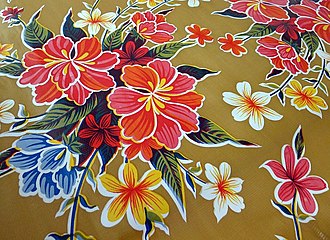Oilcloth
Oilcloth refers to a fabric material treated on one side with a waterproofing material such as linseed oil, a practice that dates back to the 18th century. Originally, oilcloth was made from heavy cotton or linen fabric coated with boiled linseed oil to make it waterproof. This type of material was used for a variety of purposes, including tablecloths, raincoats, and waterproof coverings for floors and furniture. Over time, the composition and manufacturing process of oilcloth have evolved, leading to the development of modern oilcloth made with vinyl coated with a PVC layer, which is easier to produce and maintain.
History
The use of oilcloth can be traced back to the 18th century when it was primarily used as a waterproof covering for sailing ships. Sailors treated sails with linseed oil to protect them from the harsh marine environment. This practice was later adapted for use in clothing and other materials, leading to the development of oilcloth as a waterproof fabric. In the 19th century, oilcloth became popular for use in homes as tablecloths and floor coverings because it was durable and easy to clean.
Manufacturing Process
The traditional manufacturing process of oilcloth involved coating a heavy cotton or linen fabric with multiple layers of boiled linseed oil mixed with driers and pigments. This mixture was applied to the fabric in several coats, allowing each coat to dry thoroughly before applying the next. The drying process was slow, often taking several weeks to complete. Modern oilcloth, however, is made by coating a cotton fabric with a clear PVC layer, which is quicker and less labor-intensive to produce. This new method also allows for a wider range of colors and patterns.
Uses
Oilcloth has a variety of uses, both traditional and modern. Historically, it was used for waterproof clothing, such as raincoats and hats, as well as for covering floors, furniture, and as a protective tablecloth. In contemporary times, oilcloth is still popular for tablecloths due to its durability and ease of cleaning. It is also used in crafting and sewing, for making bags, aprons, and other items that benefit from a waterproof or water-resistant surface.
Care and Maintenance
One of the advantages of oilcloth is its ease of maintenance. Traditional oilcloth required re-oiling to maintain its waterproof properties, but modern oilcloth can be easily cleaned with a damp cloth. It is not suitable for machine washing or ironing, as high heat can melt the PVC coating. Sharp objects can also puncture or tear the fabric, so care should be taken to avoid damage.
Environmental Considerations
The shift from linseed oil-based oilcloth to PVC-coated fabrics has raised environmental concerns. PVC is a plastic that can release harmful chemicals during production and disposal. As a result, there is a growing interest in finding more sustainable alternatives to PVC-coated oilcloth that still offer the same practical benefits.
Transform your life with W8MD's budget GLP-1 injections from $125.
W8MD offers a medical weight loss program to lose weight in Philadelphia. Our physician-supervised medical weight loss provides:
- Most insurances accepted or discounted self-pay rates. We will obtain insurance prior authorizations if needed.
- Generic GLP1 weight loss injections from $125 for the starting dose.
- Also offer prescription weight loss medications including Phentermine, Qsymia, Diethylpropion, Contrave etc.
NYC weight loss doctor appointments
Start your NYC weight loss journey today at our NYC medical weight loss and Philadelphia medical weight loss clinics.
- Call 718-946-5500 to lose weight in NYC or for medical weight loss in Philadelphia 215-676-2334.
- Tags:NYC medical weight loss, Philadelphia lose weight Zepbound NYC, Budget GLP1 weight loss injections, Wegovy Philadelphia, Wegovy NYC, Philadelphia medical weight loss, Brookly weight loss and Wegovy NYC
|
WikiMD's Wellness Encyclopedia |
| Let Food Be Thy Medicine Medicine Thy Food - Hippocrates |
Medical Disclaimer: WikiMD is not a substitute for professional medical advice. The information on WikiMD is provided as an information resource only, may be incorrect, outdated or misleading, and is not to be used or relied on for any diagnostic or treatment purposes. Please consult your health care provider before making any healthcare decisions or for guidance about a specific medical condition. WikiMD expressly disclaims responsibility, and shall have no liability, for any damages, loss, injury, or liability whatsoever suffered as a result of your reliance on the information contained in this site. By visiting this site you agree to the foregoing terms and conditions, which may from time to time be changed or supplemented by WikiMD. If you do not agree to the foregoing terms and conditions, you should not enter or use this site. See full disclaimer.
Credits:Most images are courtesy of Wikimedia commons, and templates, categories Wikipedia, licensed under CC BY SA or similar.
Contributors: Prab R. Tumpati, MD

